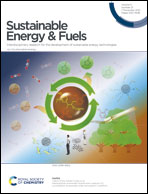Building a spontaneously formed and self-healing protective layer with an F-rich electrochemically active organic molecule for ultra-stable Li metal batteries†
Abstract
Additives in the electrolyte act as engineers in Li metal batteries. Inspired by the superior cycle performance of organic materials in half cells, tetrafluoro-1,4-benzoquinone (TFBQ), the main structure of which has been widely applied as an organic cathode material, is utilized for the first time as an additive for Li metal protection. By chemical and electrochemical reactions between TFBQ and the Li metal surface, an F-rich interface layer is in situ formed on the Li metal surface during the charge and discharge process. From electrochemical tests and characterization, the powerful self-healing ability of the interface layer enabled by TFBQ is revealed, making an extremely stable Li metal anode. By using a lean electrolyte with 0.1 M TFBQ, the cycle life of Li|Li symmetric cells is increased at least 6 times compared to the control group. Moreover, impressive full cell performance was achieved. Ultra-stable Li–LFP cells showed a 0.026% average degradation for 600 cycles at 1C and Li–NMC622 cells showed a 36.8% higher capacity compared to the control group over 200 cycles at 0.5C, which are among the best results reported. This work efficiently and conveniently provides a new research direction to Li metal protection and Li metal batteries.



 Please wait while we load your content...
Please wait while we load your content...